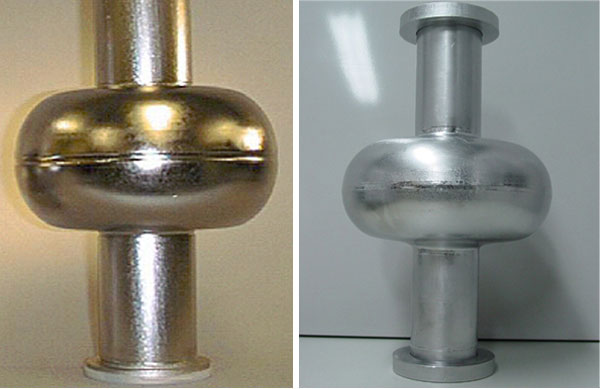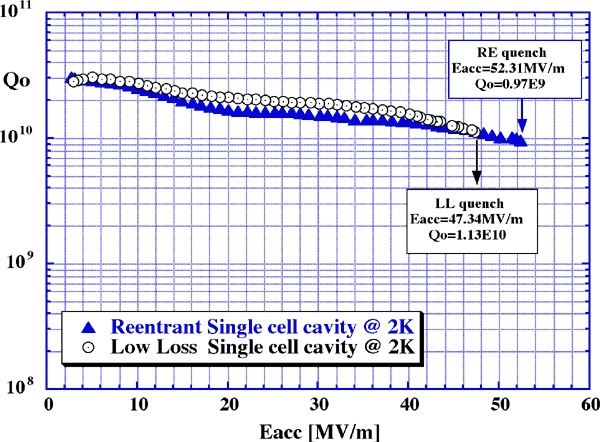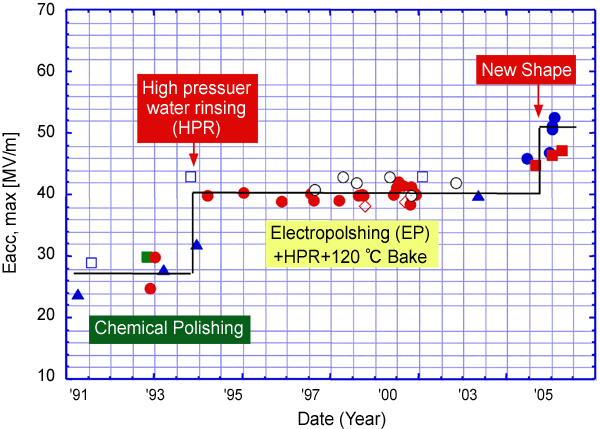Team of accelerator physicists led by associate professor Kenji Saito, High Energy Accelerator Research Organization (KEK), successfully achieved 52.3 MV/m field gradient on Niobium superconducting accelerator cavity. This gradient is an equivalent to connecting 35 million AA battery cells in series into one meter.
The high gradient superconducting cavity is one of the most vital components in designing the next generation high energy accelerators such as the International Linear Collider (ILC). Existing superconducting cavities, such as the ones developed by DESY, used to achieve 41 MV/m. Saito's group tested two types of single-cell cavities designed based on present understanding of the nature of the surface field limitation. KEK also contributed with its surface cleaning technique with ultra-high pressure water cleaning for perfecting the surface of the cavity, which is originally developed for KEK B-factory.
The two types of cavities are: the re-entrant shape (RE) figure 1 (left), designed and manufactured by Cornell University group led by Professor Hasan Padamsee, and the low-loss shape (LL), designed in collaboration by KEK, JLab and DESY, and manufactured by KEK Mechanical Engineering Center, figure 1(right). At the liquid helium temperature (2 K), the RE shape achieved the field gradient 52.3 MV/m at Qo = 0.97 x 1010, which the LL shape achieved 47.3 MV/m at Qo = 1.13 x 1010 (Fig. 1). These values are the world records, and considered to be their theoretical limits with these cavity shapes.
*) Qo is the inverse of superconductivity resistance.
"The gradient performance of cavities with traditional shape and traditional surface treatment has been limited at about 41MV/m in the past", says Saito. "Our new result corroborates a conjecture, which some of us have been trying to prove since 2001, that both the cavity shape and the surface treatment are the keys for achieving high gradients with superconducting cavities. With further studies I hope we eventually establish a new standard in building high-gradient cavities with good yield and reliability."
KEK is now developing a new 9-cell shape high gradient cavity for the ILC, called ICHIRO (for 51 MV/m objective, named for a famous baseball player's number). ILC in the present design is expected to deploy over 14,000 units of such 9-cell cavities.
 |
Figure 1 : Niobium single-cell superconducting cavity. Left: Re-entrant shape (RE). Right: Low-loss shape (LL). |
 |
Figure 2 : Acceleration feild as a function of the inverse of the superconducting resistance. Re-entrat shape cavity has achieved 52.13 MV/m with 1300MHz microwave at Qo = 0.97 x 1010. |
 |
Figure 3 : History of the maximum acceleration field. High pressure water rinsing (HPR) and electropolishing (EP) has helped improving the surface of the cavity. New shape of cavities which are designed to optimize the surface magnetic field made a breakthrough in 2005. Blue circles are of the RE shape and red rectangular are of the LL shape. |
|



